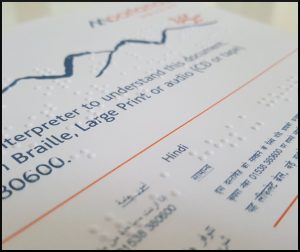16 October 2017
Getting accessible customer-service right first time
Recent research into how sensory-impaired people access disability benefits highlights problems in the PIP benefits application process. These problems are unnecessary, and hinder people from accessing the benefits they both rely on, and are entitled to.
Ensuring people can access their disability benefits is of utmost priority, and these issues need to be addressed. But we think that the report’s recommendations are applicable to many client-facing services. In this post, we highlight the key findings for you below…

Thomas Pockington Trust, the RNIB, and Sense have worked with NatCen Social Research to examine how people with a sensory impairment experience Personal Independence Payment (PIP). The study found that the Department of Work and Pensions (DWP), responsible for administering benefits, needs to make several crucial changes for the process to become truly accessible for people with a sensory impairment. We think that the recommendations made in the research could be applied to all customer-facing services. They include:
- From the first contact, make sure staff ask all applicants what their accessibility needs are.
For example, do they need Braille, Easy Read, Large Print, or a BSL interpreter? - Make sure the application form is available in accessible formats.
Poorly designed forms are not only inaccessible, but can also make the client feel they are not cared about. - Make sure all future letters and other correspondence sent to the applicant are provided in the applicants’ preferred format.
For example, it’s not good practice to send a standard print cover letter with a Large Print form. - Give applicants with sensory impairments more time to complete the application forms.
The report also highlighted how a lack of sensitivity from staff in face-to-face interviews resulted in very negative experiences for PIP applicants.
This important piece of research demonstrates how further work is needed to ensure that people with sensory impairments have equal access to goods and services. And how these simple steps above can make a huge difference to people’s experiences of the service.
For the report in detail, visit the RNIB website.
If you need guidance on how to make your application forms and documents accessible for people with vision loss, get in touch. We’re happy to help!